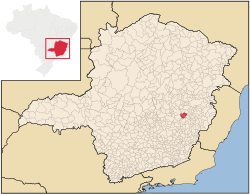Vale do Aço Metropolitan Area
| Vale do Aço Metropolitan Area | |
|---|---|
| Metropolitan Area of Brazil | |
 |
|
| Coordinates: 19°55′8.88″S 43°56′19.2″W / 19.9191333°S 43.938667°W | |
| Country |
|
| Region | Southeast |
| State |
|
| Area | |
| • Total | 807.246 km2 (311.679 sq mi) |
| Elevation | 852.19 m (2,796 ft) |
| Population | |
| • Total | 451,351 |
| • Density | 7,290.8/km2 (17,521/sq mi) |
| Time zone | BST (UTC-3) |
| • Summer (DST) | BDT (UTC-2) |
| Postal Code | 30000-000 |
| Area code(s) | +55 31 |
The Vale do Aço Metropolitan Region (pronounced: [ˈvali du ˈasu], Região Metropolitana do Vale do Aço in Portuguese) is a metropolitan area in Minas Gerais, Brazil, comprising only the four municipalities of Coronel Fabriciano, Ipatinga, Santana do Paraíso and Timóteo, but have an influence area of 22 other municipalities.
The name means Steel Valley in Portuguese. This region is also known as "a Região de Siderurgia" (Ironcasting Region), as it holds a great number of iron and steel processing companies along the course of the Rio Doce and its tributary, the Rio Piracicaba.
The industrialization was possible after the construction of the Estrada de Ferro Vitória Minas, a large railway that crossed almost untouched forest regions in the 1920s, to connect the Metropolitan Area of Vitória to Belo Horizonte. Soon after the conclusion of the railway, the ironcasting Belgo-Mineira started its activity in Coronel Fabriciano, buying local timber for charcoal production, using the it as fuel for its factories.
In 1944 Acesita, now called ArcelorMittal Timóteo, is installed in nowadays Timóteo. Acesita produces special steel, mainly the stainless steel. In 1948 the municipality of Coronel Fabriciano is emancipated, including in its domains the area of nowadays Timóteo and Ipatinga.
In 1956 Usiminas is installed in the region of Ipatinga. In 1964 both Ipatinga and Timóteo are separated from Coronel Fabriciano.
In 1973 Cenibra is installed in Belo Oriente, a municipality located in Vale do aço's influence area.
The metropolitan area was officially defined in 1998 and has a population of 430,700 (IBGE estimate 2005).
...
Wikipedia
